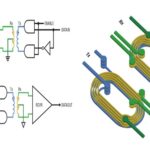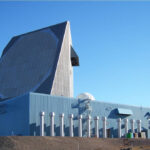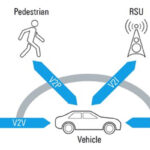In a satellite dish, as sometimes used to receive internet signals transmitted via satellite, the signal transmitted by a satellite transponder is reflected by and propagated through a circular or rectangular tube, which is part of the feedhorn. This tube, like all waveguides, has dimensions based on the wavelength of the signal. Its purpose is to confine and funnel the signal, which zigzags or bounces wall to wall along its path. The feedhorn is a channel that brings the signal to

Satellite dish antenna for Internet access.
a pickup probe, another antenna, attached to the low noise block (LNB). The LNB provides further amplification and, by combining it with an appropriate frequency generated by a local oscillator, reduces the carrier to a lower frequency so it can travel by coaxial cable to the receiver inside the building.
Problem: Many satellite installations are not grounded correctly, if at all, including those performed by professional installers. Of those that are, a large number have had an isolated (floating) ground rod that is not bonded back to the power system neutral as required by the National Electric Code (NEC). A major source of electric shock is when low-voltage wiring, including satellite coaxial lead in, comes in contact with 120-V or 240-V wiring and becomes energized.
Each lead-in conductor from any outdoor antenna, including a satellite dish, must have an antenna discharge unit, which has coaxial connectors for input and output and a grounding conductor lug. The antenna discharge unit must be located inside or outside the building, nearest the point of entrance and not near combustible material.
The reason for the discharge unit is that antennas can build up a sizeable static charge which must be dissipated. A coaxial grounding block grounds the outer shield of the coax cable to ground and thus allows static charges to dissipate without interrupting the signal.
There are also more elaborate devices that are filled with a gas which is ionized by high-voltage spikes to create a low-resistance connection to ground. This allows lightning traveling through the cable to be arrested. Both grounding blocks and arrestors are discharge units which dissipate the static charge from the antenna. Only the arrestor provides protection against lightning.
And the dish itself must be grounded. Where it swivels or turns for aiming, all articulating parts should be separately bonded and connected to a bare or insulated, solid or stranded 10 AWG copper grounding/bonding conductor, which goes to a NEC-sanctioned grounding means, such as a water pipe within five feet of entry to the building.
The grounding/bonding conductor, for one- and two-family dwellings, cannot be longer than 20 ft and should be as short as possible. Any bends should be gradual and kept to a minimum. If the distance is greater than 20 feet, drive a ground rod in close proximity. Attach the conductor to the ground rod with a ground rod clamp listed for direct burial, and drive the ground rod below grade. Using a second ground rod clamp, attach another conductor — 6 AWG bare or insulated, solid, or stranded copper — and tie into the building’s ground electrode system.
The subject of a grounding/bonding conductor brings up the question about whether the ground connection is actually making a good connection with the earth. The subject is surprisingly complicated because it involves the resistivity of the earth itself, which varies. The instrument typically used for checking earth resistance is called an earth tester. It generates an ac signal which feeds to the system under test. The instrument then checks the status of the circuits for good connections and

Here’s how Megger describes a dead-earth resistance test conducted with one of its earth testers.
noise. It informs the operator if either of these parameters are out of whack. The instrument also automatically steps through its measurement ranges to find the optimum signal to apply. By measuring the current flowing and voltage generated, the earth tester calculates and displays the system resistance which is typically in the range of 0.001 Ω for a good earth ground.
There are several methods of checking earth resistance but perhaps the simplest is called the dead earth method. It is often used when the ground connection involves bonding to a cold-water pipe. Here’s how Megger, a maker of earth testers, describes it:
When using a four-terminal instrument, P1 and C1 terminals connect to the earth electrode under test; P2 and C2 terminals connect to an all-metallic water-pipe system. With a three-terminal instrument, connect X to the earth electrode, P and C to the pipe system. If the water system is extensive (covering a large area), its resistance should only be a fraction of an ohm. You can then take the instrument reading as being the resistance of the electrode under test.
Megger points out that the dead earth method is the simplest way to make an earth resistance test. This method measures the resistance of two electrodes in series — the driven rod and the water system. But Megger also points out three important limitations:
1. The water pipe system must be extensive enough to have a negligible resistance.
2. The water pipe system also must be metallic throughout, without any insulating couplings or flanges.
3. The earth electrode under test must be far enough away from the water-pipe system to be outside its sphere of influence. Sometimes the earth electrode may be so close to the water-pipe system that the two-terminal method won’t give a valid reading. Megger says under these circumstances, if conditions 1 and 2 above are met, you can connect to the water-pipe system and obtain a suitable earth electrode. As a precaution against any possible future changes in the resistance of the water-pipe system, Megger advises installing an earth electrode.







Leave a Reply
You must be logged in to post a comment.